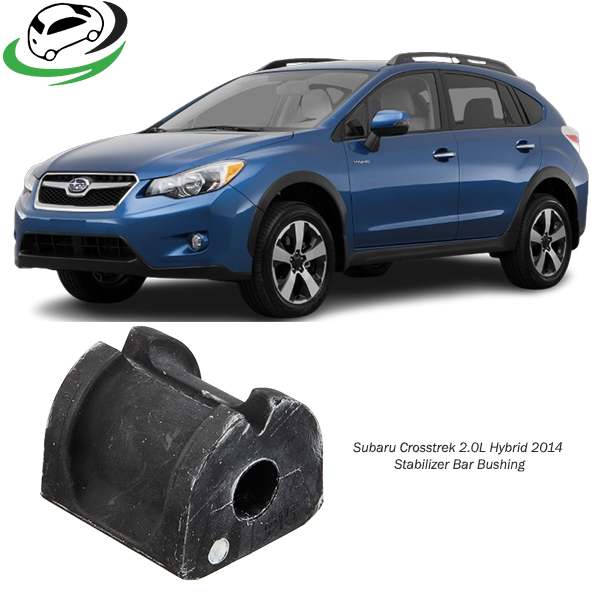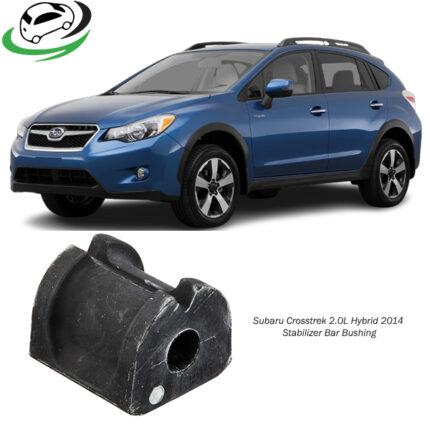Get Subaru Crosstrek 2.0L Hybrid 2014 Suspension Stabilizer Bar Bushing 20464-SC010 in Kenya
The suspension stabilizer bar bushing is a critical component of a vehicle’s suspension system, contributing to improved handling, stability, and overall comfort while driving. In this guide, we will explore the functions, benefits, components, signs of wear, and maintenance tips related to stabilizer bar bushings, also known as sway bar bushings.
1. What is a Suspension Stabilizer Bar Bushing?
A suspension stabilizer bar bushing is a small yet crucial component that attaches the stabilizer bar (or sway bar) to the chassis of the vehicle. The stabilizer bar helps reduce body roll during cornering and maintains the vehicle’s stability. The bushings, usually made from rubber or polyurethane, provide a cushion between the stabilizer bar and the vehicle frame, allowing controlled movement and reducing noise and vibrations.
Structure and Composition
- Stabilizer Bar: A metal rod running across the front or rear axle that connects the suspension components on both sides of the vehicle.
- Bushings: Made of rubber or polyurethane, these cylindrical or semi-circular components surround the stabilizer bar, securing it to the chassis.
- Brackets: Metal brackets hold the bushings and stabilizer bar in place, bolting them securely to the frame of the vehicle.
2. Functions of a Suspension Stabilizer Bar Bushing
The stabilizer bar bushing has several key functions in the suspension system, enhancing vehicle performance and ensuring driver comfort.
a. Minimizing Body Roll
The primary function of the stabilizer bar bushing is to help the stabilizer bar reduce body roll when the vehicle is taking corners. Without stabilizer bar bushings, the vehicle’s body could lean excessively, reducing control and comfort, especially during sharp turns.
b. Enhancing Vehicle Stability
By reducing body roll, the stabilizer bar bushings contribute to overall vehicle stability, ensuring the vehicle remains level during cornering. This stability is essential for maintaining control during high-speed turns or emergency maneuvers.
c. Isolating Noise and Vibrations
The bushings isolate vibrations and noise generated from road conditions, preventing them from being transmitted through the stabilizer bar to the chassis. This improves the overall ride quality and reduces road noise.
d. Allowing Controlled Flexibility
The bushings provide a small amount of flexibility that allows the stabilizer bar to move with the suspension as the vehicle goes over bumps and uneven surfaces. This flexibility helps maintain consistent tire contact with the road, improving handling and comfort.
e. Supporting Suspension Balance
The stabilizer bar bushings ensure that the stabilizer bar functions properly, balancing the suspension load between the wheels. This balance reduces uneven tire wear and contributes to better handling.
3. Benefits of Properly Functioning Suspension Stabilizer Bar Bushings
When stabilizer bar bushings are in good condition, they provide several benefits that enhance both the driving experience and the vehicle’s overall performance.
a. Improved Handling
Properly functioning stabilizer bar bushings reduce body roll, ensuring that the vehicle handles smoothly around corners and during sharp maneuvers. This is particularly important for drivers who prioritize responsive handling and performance.
b. Enhanced Comfort
By minimizing road vibrations and noise, stabilizer bar bushings improve ride comfort for both the driver and passengers. The bushings help absorb road shocks, making the drive smoother even on uneven surfaces.
c. Increased Suspension Longevity
Well-maintained stabilizer bar bushings reduce stress on other suspension components, including control arms, tie rods, and strut mounts. This prevents premature wear and extends the lifespan of the suspension system.
d. Better Tire Contact with the Road
Proper stabilizer bar bushings allow for consistent tire contact with the road, especially during turns. This ensures better traction, improved handling, and reduced tire wear.
e. Reduced Vehicle Wear and Tear
By cushioning the stabilizer bar’s movements and reducing vibrations, stabilizer bar bushings decrease wear on the stabilizer bar and the suspension components it connects to. This reduces the need for frequent repairs.
4. Signs of a Failing Suspension Stabilizer Bar Bushing
Like any vehicle component, stabilizer bar bushings can wear out over time, especially with constant exposure to harsh road conditions, moisture, and debris. Here are common signs that the bushings may be failing:
a. Clunking or Knocking Noises
One of the most noticeable signs of worn stabilizer bar bushings is clunking or knocking noises, especially when driving over bumps or making turns. This noise indicates that the stabilizer bar is loose and hitting the frame, as the bushings are no longer providing proper cushioning.
b. Excessive Body Roll
If you notice that the vehicle leans more than usual during turns, this is a sign that the stabilizer bar bushings may be worn. Without effective bushings, the stabilizer bar cannot properly control body roll.
c. Poor Handling
A vehicle with worn stabilizer bar bushings may feel less stable, particularly during cornering or sudden lane changes. If the steering feels looser than usual, it could indicate that the bushings are failing to support the stabilizer bar’s function.
d. Squeaking Noises
In addition to clunking, you might hear squeaking noises from the suspension, especially when driving over uneven surfaces. This squeaking occurs as the metal stabilizer bar rubs against the chassis without the proper cushioning of the bushings.
e. Uneven Tire Wear
Failing stabilizer bar bushings can contribute to uneven tire wear, as the vehicle may lean excessively or handle poorly, placing more pressure on certain tires during turns or sudden stops.
5. Maintenance of Suspension Stabilizer Bar Bushings
Regular maintenance and timely replacement of stabilizer bar bushings are essential for ensuring vehicle performance and safety. Here are several key tips for maintaining these components:
a. Routine Inspections
It’s important to inspect the stabilizer bar bushings during regular maintenance checks. Look for signs of wear, such as cracks, tears, or deformities in the rubber. If you notice any signs of deterioration, it may be time to replace the bushings.
b. Monitor for Noises and Poor Handling
Be attentive to any unusual noises or changes in handling. If you hear clunking, knocking, or squeaking noises, or notice that the vehicle’s handling has become less stable, inspect the stabilizer bar bushings immediately.
c. Lubrication (for Certain Bushings)
Some aftermarket polyurethane bushings require lubrication to reduce friction and prevent squeaking. Follow the manufacturer’s recommendations for lubrication intervals and products.
d. Replace Worn Bushings Promptly
If the stabilizer bar bushings are worn, replace them as soon as possible. Driving with worn bushings can lead to further damage to the suspension system and affect overall safety and handling.
e. Keep Bushings Clean
Keeping the bushings clean from dirt, road grime, and moisture helps prevent premature wear. Regular cleaning with mild soap and water, followed by drying, can help prolong their lifespan.
6. Steps to Replace Suspension Stabilizer Bar Bushings
Replacing suspension stabilizer bar bushings is a relatively straightforward process that can typically be completed with basic tools. Here’s a general guide on how to replace them:
1. Gather the Necessary Tools
You’ll need basic tools such as a socket set, wrench, jack, jack stands, and the replacement bushings. Some bushings may require lubricant for installation.
2. Raise the Vehicle
Use a jack to lift the vehicle and secure it on jack stands. This will provide access to the stabilizer bar and bushings.
3. Locate the Stabilizer Bar and Bushings
Identify the stabilizer bar, which runs across the front or rear axle of the vehicle. The bushings are typically located where the bar connects to the chassis.
4. Remove the Mounting Brackets
Using a socket or wrench, remove the bolts securing the mounting brackets that hold the bushings in place. Carefully remove the brackets to access the bushings.
5. Remove the Old Bushings
Slide the old bushings off the stabilizer bar. If they are cracked, torn, or deformed, replacement is necessary.
6. Install the New Bushings
Slide the new bushings onto the stabilizer bar in the same position as the old ones. Make sure the bushings are properly aligned.
7. Reattach the Mounting Brackets
Reinstall the mounting brackets over the new bushings and secure them with the bolts. Ensure that the brackets are tightened to the manufacturer’s specifications.
8. Lower the Vehicle
Once the new bushings are installed and the brackets are secure, carefully lower the vehicle.
9. Test Drive the Vehicle
After replacing the bushings, take the vehicle for a test drive to ensure that the clunking noises have disappeared and that the handling has improved.
Conclusion
Suspension stabilizer bar bushings are crucial components that contribute to a vehicle’s handling, stability, and comfort. By reducing body roll, absorbing road vibrations, and maintaining balance between the suspension components, stabilizer bar bushings play a key role in ensuring a smooth and safe driving experience. Regular inspection, maintenance, and timely replacement of worn bushings will help ensure that your vehicle continues to perform optimally on the road.
Follow us on Facebook for more parts.





Reviews
Clear filtersThere are no reviews yet.